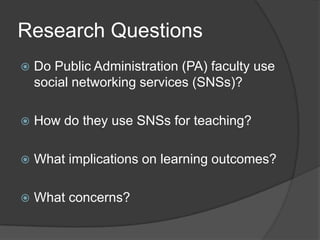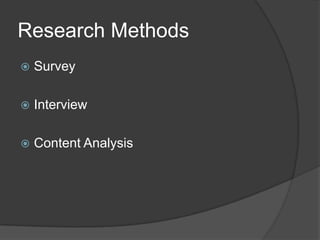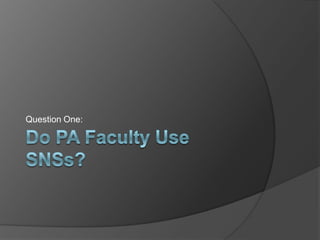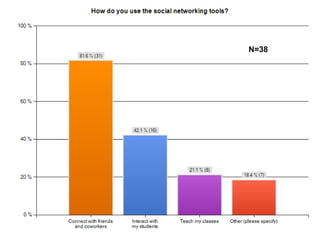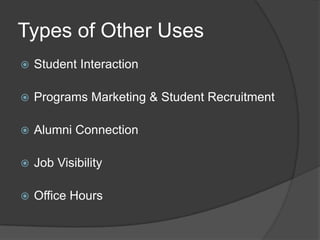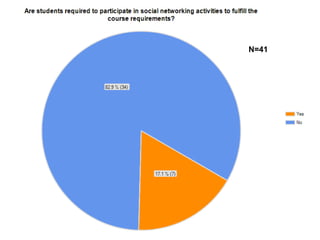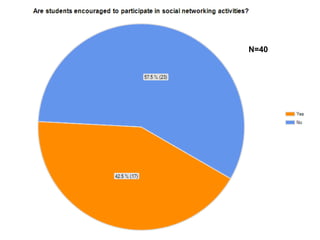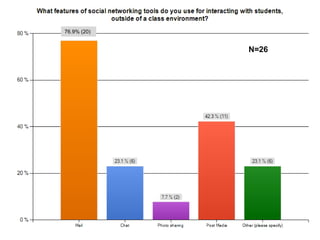Social Networking in Teaching Public Administration
- 1. Social Networking in Teaching Public AdministrationBaiyun Chen, University of Central FloridaThomas Bryer, University of Central Florida
- 3. Social Networking & Public Administration
- 4. Research QuestionsDo Public Administration (PA) faculty use social networking services (SNSs)?How do they use SNSs for teaching?What implications on learning outcomes? What concerns?
- 7. N=42
- 8. N=44
- 9. Do PA Faculty Use SNSs?Question One:
- 10. N=56
- 12. N=39
- 13. How Do They Use SNSs for Teaching?Question Two:
- 14. N=38
- 15. Types of Other UsesStudent InteractionPrograms Marketing & Student RecruitmentAlumni ConnectionJob VisibilityOffice Hours
- 16. N=41
- 17. N=41
- 18. N=40
- 19. N=37
- 20. What Activities Do You Use with SNSs?
- 21. N=23
- 22. 76.9% (20)N=26
- 23. What Implications on Learning Outcomes? Question Three:
- 27. Not Improve Learning Outcomes
- 28. Not Sure About Learning Outcomes
- 32. Other Concerns
- 33. Please fill out our session evaluation and access the survey at:http://tinyurl.com/sloansns
Editor's Notes
- Social networking services focus on building online communities of people who share interests and activities, or who are interested in exploring the interests and activities of others. Most social network services are Web based and provide a variety of ways for users to interact, such as e-mail and instant messaging services. These Web-based services have created powerful new ways to communicate and share information which can possibly be used to promote learning community and collaboration. Data: August 2009All stats are from Google Ad PlannerSocial networking sites among US internet users, May 2008 (131,808,000) - May 2009 (147,009,000 unique visitors), 12% increase.Facebook (97% increase)EDUCAUSE. (2009). The ECAR Study of Undergraduate Students and Information Technology, 2009. Retrieved October 22, 2009, from http://www.educause.edu/ers0906Data for 4-year comparisons are based on student responses from 39 undergraduate institutions (2006-2009)90.3% respondents uses SNSs in 2009; only 27.8% reported using them in a course during the quarter or semester of the survey.Tom: Personal use: connect with friendsProfessional use: Scholar exchangeAcademic use: supplement classes – post news article; facilitate comments/discussions; open channel to students, in contact with students and faculty outside of UCFNing: A long-term goal for students community; In classes, announcement & groupwork. Not required
- Web 2.0 social networking technologies are an increasingly central part of life for college students. Despite the increasing use of these tools for social interaction, political organization, professional development, and entertainment, there is a lack of understanding regarding the ways in which university faculty can best tap into these tools to enhance educational experiences and learning outcomes. This study addressed the following five questions, which are written based on the limited literature on this topic:1. What is the level of familiarity for public administration faculty in the United States of Facebook and other social networking Web 2.0 tools?2. What ethical concerns do public administration faculty members have with respect to social networking Web 2.0 tools? (For instance, Beckenham discusses her concern about perceived preferential treatment or inappropriate or too informal relations between teacher and student). 3. What technology capabilities do public administration faculty members have to effectively use social networking Web 2.0 tools, and what barriers exist for more effective use of such tools?4. For those public administration faculty members who have experience using social networking Web 2.0 tools, what lessons can be learned from their experiences in order to improve the use of social networking in face-to-face and online teaching? 5. How can social networking Web 2.0 tools be used to enhance values of citizenship and democracy—a central concern to many public administration scholars?
- First, a survey is conducted through the web with all faculty members at the top 100 public administration programs in the United States. The survey instrument includes questions on uses of social networking tools in teaching, as well as in general. Particularly, it aims to collect information on how faculty members integrate social networking tools in classes and communicate with students, how these tools impact students’ learning outcome and concerns for using them for education. The survey instrument is available upon request.Second, semi-structured interviews are conducted with faculty who indicate that they are familiar with and use or have used Facebook or another social networking platform to complement their teaching. The first two stages have been carrying out since December, 2008. It is scheduled that survey data collection will be completed by fall, 2009, and then further analysis will be conducted.Third, a series of focus groups will be conducted both face-to-face with faculty and remotely using Adobe Connect. The purpose of these groups will be to demonstrate different social networking tools and to seek faculty feedback on their use, including envisioned usage. Additionally, public administration faculty will be asked to consider how these tools might be used to strengthen citizenship and our democratic institutions—the focus of much of our work in the discipline of public administrationFourth, we will conduct a content analysis of course syllabi that use Facebook, as identified by our respondents. We also will conduct a content analysis of faculty Facebook or other social networking websites to capture current practices. It is scheduled that the focus group meetings and content analysis will start in late 2009 after all survey data collected is completed.
- N=56N (Q13) = 39




